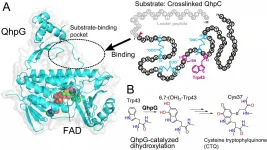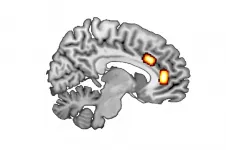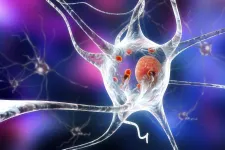(Press-News.org) CHAMPAIGN, Ill. -- When modified using a process known as epoxidation, two naturally occurring lipids are converted into potent agents that target multiple cannabinoid receptors in neurons, interrupting pathways that promote pain and inflammation, researchers report. These modified compounds, called epo-NA5HT and epo-NADA, have much more powerful effects than the molecules from which they are derived, which also regulate pain and inflammation.
Reported in the journal Nature Communications, the study opens a new avenue of research in the effort to find alternatives to potentially addictive opioid pain killers, researchers say.
The work is part of a long-term effort to understand the potentially therapeutic byproducts of lipid metabolism, a largely neglected area of research, said University of Illinois Urbana-Champaign comparative biosciences professor Aditi Das, who led the study. While many people appreciate the role of dietary lipids such as omega-3 and omega-6 fatty acids in promoting health, the body converts these fat-based nutrients into other forms, some of which also play a role in the healthy function of cells, tissues and organ systems.
"Our bodies use a lot of genes for lipid metabolism, and people don't know what these lipids do," said Das, also an affiliate of the Beckman Institute for Advanced Science and Technology and of the Cancer Center at Illinois. "When we consume things like polyunsaturated fatty acids, within a few hours they are transformed into lipid metabolites in the body."
Scientists tend to think of these molecules as metabolic byproducts, "but the body is using them for signaling processes," Das said. "I want to know the identity of those metabolites and figure out what they are doing."
She and her colleagues focused on the endocannabinoid system, as cannabinoid receptors on cells throughout the body play a role in regulating pain. When activated, cannabinoid receptors 1 and 2 tend to reduce pain and inflammation, while a third receptor, TRPV1, promotes the sensation of pain and contributes to inflammation. These receptors work together to modulate the body's responses to injury or disease.
"Understanding pain regulation in the body is important because we know we have an opioid crisis," Das said. "We're looking for lipid-based alternatives to opioids that can interact with the cannabinoid receptors and in the future be used to design therapeutics to reduce pain."
Previous research identified two lipid molecules, known as NA5HT and NADA, that naturally suppress pain and inflammation. Das and her colleagues discovered that brain cells possess the molecular machinery to epoxidize NA5HT and NADA, converting them to epo-NA5HT and epo-NADA. Further experiments revealed that these two epoxidated lipids are many times more potent than the precursor molecules in their interactions with the cannabinoid receptors.
"For example, we found that epo-NA5HT is a 30-fold stronger antagonist of TRPVI than NA5HT and displays a significantly stronger inhibition of TRPV1-mediated responses in neurons," Das said. It inhibits pathways associated with pain and inflammation, and promotes anti-inflammatory pathways.
The team was unable to determine whether neurons naturally epoxidate NA5HT and NADA in the brain, but the findings hold promise for the future development of lipid compounds that can combat pain and inflammation without the dangerous side effects associated with opioids, Das said.
INFORMATION:
The Das research group collaborated with Hongzhen Hu, a pain and itch researcher and professor of anesthesiology at Washington University in St. Louis, and with U. of I. biochemistry professor Emad Tajkhorshid, who helped simulate how the lipids are metabolized by enzymes known as cytochrome P450s.
Tajkhorshid also is an affiliate of the Beckman Institute.
The National Institutes of Health support this research.
Editor's notes:
To reach Aditi Das, email aditidas@illinois.edu.
The paper "Anti-inflammatory dopamine- and serotonin-based endocannabinoid epoxides reciprocally regulate cannabinoid receptors and the TRPV1 channel" is available to members of the media from the U. of I. News Bureau.
Tokyo, Japan - Researchers from Institute of Industrial Science at The University of Tokyo investigated the mechanism of phase separation into the two phases with very different particle mobilities using computer simulations. They found that slow dynamics of complex connected networks control the rate of demixing, which can assist in the design of new functional porous materials, like lithium-ion batteries.
According to the old adage, oil and water don't mix. If you try to do it anyway, you will see the fascinating process of phase separation, in which the two immiscible liquids spontaneously "demix." In this case, the minority phase always forms droplets. Contrary to this, the researchers ...
Osaka, Japan - Investigators from the Institute of Scientific and Industrial Research at Osaka University, together with Hiroshima Institute of Technology, have announced the discovery of a new protein that allows an organism to conduct an initial and essential step in converting amino acid residues on a crosslinked polypeptide into an enzyme cofactor. This research may lead to a better understanding of the biochemistry underlying catalysis in cells.
Every living cell is constantly pulsing with an array of biochemical reactions. The rates of these reactions are controlled by special proteins called enzymes, which catalyze specific processes that would otherwise take much longer. A number of enzymes require specialized molecules called "cofactors," which can help shuttle electrons ...
As indicated by other studies, different parts of the brain are responsible for different types of decisions. A research team led by Luca Franziska Kaiser and Prof. Dr. Gerhard Jocham from the HHU working group 'Biological Psychology of Decision Making', and Dr. Theo Gruendler together with colleagues in Magdeburg analysed the balance of the messenger substances GABA and glutamate in two forms of decision-making. The background to the research was to find out how different concentrations of these substances influence the person making the decision.
On the one hand, the researchers looked at 'reward-based decisions', which involve maximising reward by selecting the better of two ...
It is now possible to capture images of planets that could potentially sustain life around nearby stars, thanks to advances reported by an international team of astronomers in the journal Nature Communications.
Using a newly developed system for mid-infrared exoplanet imaging, in combination with a very long observation time, the study's authors say they can now use ground-based telescopes to directly capture images of planets about three times the size of Earth within the habitable zones of nearby stars.
Efforts to directly image exoplanets - planets outside our solar system - have been hamstrung by technological limitations, resulting in a bias toward the detection of easier-to-see planets that are much larger than Jupiter and are located around very young stars and far outside the ...
A study published in Nature Communications today (Wednesday 10 February) presents a compelling new evidence about what a key protein called alpha-synuclein actually does in neurons in the brain.
Dr Giuliana Fusco, Research Fellow at St John's College, University of Cambridge, and lead author of the paper, said: "This study could unlock more information about this debilitating neurodegenerative disorder that can leave people unable to walk and talk. If we want to cure Parkinson's, first we need to understand the function of alpha-synuclein, a protein present in everyone's brains. ...
While deforestation levels have decreased significantly since the turn of the 21st century, the United Nations (UN) estimates that 10 million hectares of trees have been felled in each of the last five years.
Aside from their vital role in absorbing CO2 from the air, forests play an integral part in maintaining the delicate ecosystems that cover our planet.
Efforts are now underway across the world to rectify the mistakes of the past, with the UN Strategic Plan for Forests setting out the objective for an increase in global forest coverage by 3% by 2030.
With time being of the essence, one of the most popular methods of reforestation in humid, tropical regions ...
Commuters now have yet another reason to avoid packing themselves into subway stations. New York City's transit system exposes riders to more inhaled pollutants than any other metropolitan subway system in the Northeastern United States, a new study finds. Yet even its "cleaner" neighbors struggle with enough toxins to give health-conscious travelers pause.
Led by NYU Grossman School of Medicine researchers, the study measured air quality samples in 71 stations at morning and evening rush hours in Boston, New York City, Philadelphia, and Washington, D.C. ...
A treatment, known as KEDRAB (Rabies Immune Globulin [Human]), currently used in the prevention of rabies has been demonstrated to be safe and effective for patients age 17 and under.
Results published today in Human Vaccines & Immunotherapeutics report the first and only pediatric trial of any human rabies immunoglobulin (HRIG) currently available in the US. Findings have been submitted to the US Food and Drug Administration for review.
In the United States, someone is treated for possible exposure to rabies every 10 minutes. Globally, the World ...
A new paper in Oxford Open Immunology, published by Oxford University Press, examines prior findings in the field of neuroimmunology that suggest potential treatment strategies for patients suffering long-term symptoms from COVID-19.
Though COVID-19 was initially believed to be a short-term illness, lasting between one and three weeks, it's clear that a substantial number of patients will experience symptoms beyond that, with some patients suffering from health problems for more 12 weeks. In fact, for patients who were initially hospitalized, more than 80% reported at least one symptom that persisted beyond the first month.
The symptoms of long-COVID can vary widely, ...
Yams are a staple food in West Africa, which produces over 90% of the world's yams each year. Yams play a key role in the food security, economic income, and traditional culture for the region.
While they are commonly assumed to be the same as sweet potatoes in the U.S., yams are a completely different plant. The yam tubers are much starchier and drier compared to sweet potatoes. Yams are native to Africa and Asia, and most Americans have never had a true yam.
Even though yam is a staple crop for West Africa, there has been limited research to improve the genetic diversity or productivity.
Researcher Shinsuke Yamanaka focuses on improving crop breeding resources for ...






